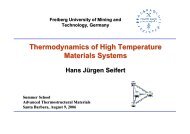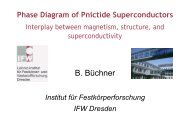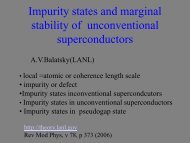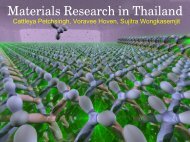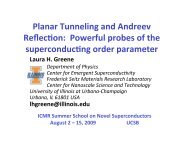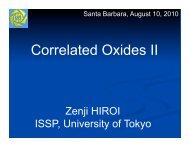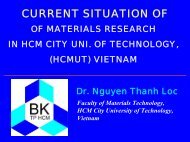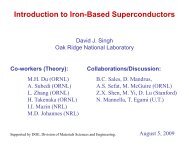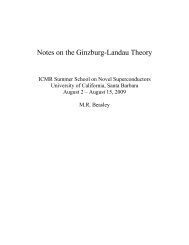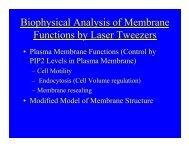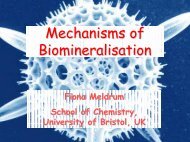a simple superconductor?
a simple superconductor?
a simple superconductor?
You also want an ePaper? Increase the reach of your titles
YUMPU automatically turns print PDFs into web optimized ePapers that Google loves.
FeSe – a <strong>simple</strong> <strong>superconductor</strong>?<br />
Claudia Felser<br />
Vadim Ksenofontov, Fred Casper, Shahab Naghavi<br />
T. M. McQueen, A. J. Williams, R. J. Cava<br />
S. Medvedev, I. Trojan, T. Palasyuk, Mikhail I. Eremets,<br />
G. Wortmann<br />
Universität Mainz<br />
University of Princeton<br />
MPI-Chemie, Mainz<br />
Universität Paderborn
• My background<br />
• FeSe<br />
•Stoichiometry<br />
•Pressure<br />
•Doping<br />
• Summary<br />
• Interesting crystal structures<br />
ICMR Summer School on Novel Superconductors 2009
Rational Design<br />
Synthesis<br />
computational<br />
design<br />
structure<br />
nano particles<br />
single crystals<br />
spectroscopy<br />
thin films<br />
ceramics<br />
ICMR Summer School on Novel Superconductors 2009
FeSe<br />
The estimated upper critical field<br />
Hc2 (0) is ~ 16.3 T, which<br />
gives a coherence length<br />
ξ 0 ~ 4.5 nm.<br />
ICMR Summer School on Novel Superconductors 2009
FeSe<br />
A key observation is that the clean<br />
superconducting phase exists only<br />
in those samples prepared with<br />
intentional Se deficiency.<br />
• A small magnetic anomaly is<br />
observed at 105 K, which is more<br />
pronounced in the FC<br />
measurements.<br />
• Inset shows the magnetic<br />
hysteresis of the sample<br />
measured at 2 K. It confirms the<br />
superconducting characteristic of<br />
the sample.<br />
ICMR Summer School on Novel Superconductors 2009
Doping of Fe 1.01 Se<br />
ICMR Summer School on Novel Superconductors 2009
Fe 1.01±0.2 Se<br />
Superconductivity depends<br />
strongly on the stoichiometry<br />
100% superconducting sample<br />
for Fe 1.01±0.2 Se<br />
Excess Fe instead of<br />
Se deficiency<br />
McQueen et al. Phys. Rev. B 79 (2009) 014522<br />
ICMR Summer School on Novel Superconductors 2009
• Freshly polished iron pieces and<br />
selenium shot<br />
• Sealed in silica tubes under<br />
vacuum with a piece of cleaned<br />
carbon<br />
• Sealed in a second evacuated<br />
silica ampoule<br />
• Complex annealing procedure<br />
• Small pieces were then loaded<br />
into small silica ampoules and<br />
annealed at various temperatures<br />
300–500 °C or 2 days followed by<br />
quenching in −13 °C brine.<br />
Protection from oxidation in air by<br />
storage in an argon glove box.<br />
Fe 1.01 Se<br />
McQueen et al. Phys. Rev. B 79 (2009) 014522<br />
ICMR Summer School on Novel Superconductors 2009
Fe 1.01 Se<br />
• No long range magnetic<br />
interaction in superconducting<br />
Fe 1.01 Se<br />
• No long range magnetic<br />
interaction in non<br />
superconducting Fe 1.03 Se<br />
• Impurities suppress<br />
superconductivity<br />
McQueen et al. Phys. Rev. B 79 (2009) 014522<br />
ICMR Summer School on Novel Superconductors 2009
Fe 1.01 Se<br />
McQueen et al. Phys. Rev. B 79 (2009) 014522<br />
ICMR Summer School on Novel Superconductors 2009
Fe 1.01 Se below 100 K: dimer formation<br />
•On cooling, Fe 1.01 Se<br />
undergoes a twisting of<br />
the tetrahedra, splitting<br />
the Fe-Fe distances into<br />
two distinct sets.<br />
•Nonsuperconducting<br />
Fe 1.03 Se, in contrast,<br />
shows no transition by<br />
XRD.<br />
McQueen et al., Phys. Rev. Lett 103 057002 (2009).<br />
ICMR Summer School on Novel Superconductors 2009
Fe 1.01 Se below 100 K: dimer formation<br />
The first is by displacement<br />
of pairs of iron ions along<br />
the short in-plane a-axis.<br />
This is consistent with<br />
the formation of Fe-Fe<br />
dimers, which would<br />
imply that the transition is<br />
driven by an increase in<br />
metal-metal bonding.<br />
McQueen et al., Phys. Rev. Lett 103 057002 (2009).<br />
ICMR Summer School on Novel Superconductors 2009
Tetra-Ortho transition in Fe 1.01 Se below 100 K<br />
0,085<br />
0,080<br />
0,075<br />
A norm<br />
0,070<br />
0,065<br />
0,060<br />
0,055<br />
Normalized area under Mössbauer<br />
spectra is sensitive to the tetra- ortho<br />
transition.<br />
Ortho phase is more soft<br />
The non superconducting phases are<br />
less soft<br />
0 50 100 150 200 250 300<br />
T, K<br />
Dependence of the Mössbauer-Lamb<br />
factor from the properties<br />
Fe 1.01<br />
Se f = 0.11(1)<br />
Fe 1.03<br />
Se f = 0.16(1)<br />
Fe 0.97<br />
Cu 0.04<br />
Se f = 0.18(1)<br />
McQueen et al., Phys. Rev. Lett (2009).<br />
ICMR Summer School on Novel Superconductors 2009
Fe 1.01 Se<br />
• Estimation of the normalized<br />
specific-heat jump at Tc is<br />
C/Tc=1.31, which is in good<br />
agreement with the BCS<br />
expected value of 1.4.<br />
• This confirms the bulk nature<br />
of the superconductivity below<br />
8.5 K in Fe 1.01 Se-300 °C.<br />
• There is a second transition at<br />
1K in the superconducting<br />
sample<br />
McQueen et al. Phys. Rev. B 79 (2009) 014522<br />
ICMR Summer School on Novel Superconductors 2009
FeSe: superconductivity under pressure<br />
Y. Mizuguchi, et al Appl. Phys. Lett. 93, 152505 2008<br />
ICMR Summer School on Novel Superconductors 2009
Fe 1.01 Se under pressure: Transport<br />
M. I. Eremets, et al., Science 319,<br />
1506 (2008)<br />
Medvedev et al. Nat. Mat. 8 630 (2009) arXiv:0903.2143<br />
ICMR Summer School on Novel Superconductors 2009
Fe 1.01 Se under pressure: Transport<br />
40<br />
T Onset C (K)<br />
35<br />
30<br />
25<br />
20<br />
15<br />
10<br />
eye guide only<br />
Quasi 4 probe method<br />
Van-der-Pauw method<br />
• Maximum of T C : 37 K at 8.9 GPa<br />
5<br />
0 5 10 15 20 25<br />
Pressure (GPa)<br />
Medvedev et al. Nat. Mat. 8 630 (2009) arXiv:0903.2143<br />
ICMR Summer School on Novel Superconductors 2009
Fe 1.01 Se under pressure: Transport<br />
40<br />
T Onset C (K)<br />
35<br />
30<br />
25<br />
20<br />
15<br />
10<br />
5<br />
eye guide only<br />
Quasi 4 probe method<br />
Van-der-Pauw method<br />
0 5 10 15 20 25<br />
Pressure (GPa)<br />
• Confirmed by other groups<br />
Medvedev et al. Nat. Mat. 8 630 (2009) arXiv:0903.2143<br />
ICMR Summer School on Novel Superconductors 2009
Fe 1.01 Se under pressure: Structure<br />
• Superconductivity depends<br />
strongly on the stoichiometry<br />
• Very soft material<br />
• Transforms under pressure<br />
into the NiAs type structure<br />
• Struture determinations were<br />
done at<br />
•ESRF<br />
•Taiwan<br />
•SPring8<br />
Medvedev et al. Nat. Mat. 8 630 (2009)<br />
arXiv:0903.2143<br />
ICMR Summer School on Novel Superconductors 2009
Fe 1.01 Se<br />
• Limitation of superconductivity related to the<br />
tetragonal phase (black) by the appearance of the<br />
hexagonal more dense semiconducting phase (red)<br />
• Nicely seen also in the Mößbauerspectra: the isomer<br />
shift of the tetragonal covalent FeSe is smaller<br />
compared to the hexagonal FeSe<br />
• The hexagonal FeSe exists under ambient conditions<br />
only off stochiometric and is magnetic<br />
• The transition is reversible<br />
ICMR Summer School on Novel Superconductors 2009
Fe 1.01 Se<br />
• Anomalous p-<br />
dependence of the<br />
Debye Waller factor<br />
• Phonon softening<br />
observed for the<br />
superconducting phase<br />
• Limited by the<br />
appearance of the<br />
hexagonal phase<br />
• Electron phonon<br />
coupling might be also<br />
important<br />
Ksenofontov et al. To be published<br />
ICMR Summer School on Novel Superconductors 2009
Hexagonal Fe 1.01 Se<br />
Semiconducting ground state of the NiAs phase can not described<br />
within the LSDA<br />
Medvedev et al. et arXiv:0903.2143; al. Nat. Mat. 8 Nature 630 (2009) Mat. (2009) arXiv:0903.2143<br />
ICMR Summer School on Novel Superconductors 2009
Tetragonal FeSe<br />
Shahab Naghavi with Crystal06<br />
and Hybridfunctional<br />
ICMR Summer School on Novel Superconductors 2009
Fe 1.01 Se<br />
Tetragonal to orthorhombic transition ~100K only in the<br />
superconducting phase<br />
Linear resistance of the orthorhombic phase: anomalous metal?<br />
Medvedev et al. Nat. Mat. 8 630 (2009)<br />
arXiv:0903.2143<br />
McQueen et al. PRL 103, 057002<br />
arXiv:0905.1065v1 (2009).<br />
ICMR Summer School on Novel Superconductors 2009
Fe 1.01 Se: evidence for quantum critcality<br />
ICMR Summer School on Novel Superconductors 2009
Fe 1.01 Se<br />
77<br />
Se NMR spin-lattice relaxation<br />
rate, 1/T 1 :<br />
• Strong enhancement towards<br />
Tc of antiferromagnetic spin<br />
fluctuations<br />
• Hydrostatic pressure<br />
enhances spin fluctuations as<br />
well as Tc.<br />
• Electronic properties of FeSe<br />
are very similar to those of<br />
electron-doped FeAs<br />
<strong>superconductor</strong>s,<br />
T. Imai et al. PRL 102, 177005 (2009)<br />
ICMR Summer School on Novel Superconductors 2009
Fe 1.01 Se<br />
This finding suggests that<br />
undoped FeSe <strong>superconductor</strong><br />
is actually on the verge of an<br />
SDW ordering.<br />
T. Imai et al. PRL 102, 177005 (2009)<br />
ICMR Summer School on Novel Superconductors 2009
The Phase diagram of Fe 1.01 Se<br />
Zhao et al., arXiv:0806.2528<br />
• Structural phase transition above T C<br />
• No spin density wave instability<br />
• Reversible phase transition: NiAs structure<br />
Medvedev et al. et arXiv:0903.2143; al. Nat. Mat. 8 Nature 630 (2009) Mat. (2009) arXiv:0903.2143<br />
ICMR Summer School on Novel Superconductors 2009
Doping of FeSe<br />
Al, Ga, Sm occupies the Fe sites – no possitiv influence on the<br />
superconducting properties<br />
Ti, V, Cr destroys superconductivity<br />
ICMR Summer School on Novel Superconductors 2009
Doping of FeSe<br />
ICMR Summer School on Novel Superconductors 2009
Metal – Insulator Transition in Fe 1.01-x Cu x Se<br />
• Cu substitute Fe up to a solubility limit of 20–30%, after<br />
which a first-order transition to the three-dimensional<br />
CuFeSe 2 structure type is observed<br />
A J WilliamsJ. et Phys.: al. J. Condens. Phys.: Condens. Matter 21 Matter (2009) 305701 21 (2009) 305701<br />
ICMR Summer School on Novel Superconductors 2009
Metal – Insulator Transition in Fe 1.01-x Cu x Se<br />
Cu doping changes the Fe-Fe distances<br />
1% doping – no Meißner effect<br />
Mott transition can be induced above 4% Cu doping<br />
A J WilliamsJ. et Phys.: al. J. Condens. Phys.: Condens. Matter 21 Matter (2009) 305701 21 (2009) 305701<br />
ICMR Summer School on Novel Superconductors 2009
Metal – Insulator Transition in Fe 1.01-x Cu x Se<br />
• Variation of magnetic<br />
susceptibility of the<br />
Fe 1.01−x Cu x Se samples with<br />
temperature<br />
• A clear increase in the<br />
local moment with x is<br />
observed, culminating in a<br />
spin-glass-type transition at<br />
Fe 0.89 Cu 0.12 Se, which then<br />
broadens out at higher<br />
dopings.<br />
This finding suggests that undoped FeSe <strong>superconductor</strong><br />
is actually on the verge of an SDW ordering.<br />
A J Williams et al. J. Phys.: Condens. Matter 21 (2009) 305701<br />
ICMR Summer School on Novel Superconductors 2009
ICMR Summer School on Novel Superconductors 2009
What is different in FeSe compared<br />
to the ironpnictides<br />
-highest TC among the binary SC<br />
-FeSe is SC in the parent phase<br />
-SC depends strongly on the stoichiometry<br />
-The SC is connected to the tetra to ortho<br />
transition<br />
-disappearance of SC is connected with the<br />
phase transition into NiAs<br />
-no static magnetism over the whole phase<br />
diagram<br />
-short range magnetic fluctuations<br />
-pressure induced TC increase is not related to<br />
the suppression magnetism<br />
–phonons and spin fluctuations play a crucial<br />
role for SC<br />
ICMR Summer School on Novel Superconductors 2009
Ingredients for high temperature<br />
<strong>superconductor</strong>s (Mac Beasley)<br />
-symmetry<br />
-anisotropy<br />
-short coherence length<br />
(high N_EF, low v_EF)<br />
-low charge carrier density<br />
Does the structure type count?<br />
ICMR Summer School on Novel Superconductors 2009
Valence fluctuation – Superconductivity- Magneto resistance<br />
Goal: rational Syntheses of Compounds with special<br />
electronic and magnetic properties<br />
• Valence fluctuations<br />
• Superconductivity<br />
• Magneto resistance<br />
• Same Structure type<br />
• Electronic fingerprint<br />
ICMR Summer School on Novel Superconductors 2009
Valence fluctuation – Superconductivity- Magneto resistance<br />
Perovskite<br />
Inverse<br />
Perovskite<br />
EuPd 3 B<br />
Cuprates<br />
Bismutates<br />
MgNi 3 C<br />
Manganites<br />
Th 3 P 4 Eu 3 S 4 La 3 S 4 Gd 3 S 4<br />
Pu 4 (C 2 ) 3 Rb 4 (O 2 ) 3 Y 4 (C 2 ) 3<br />
AlB 2 EuNiP ZrRuP<br />
MgB 2<br />
TaS 2 NbSe 2 GdI 2<br />
Heusler Pd 2 ZrAl Co 2 TiSn<br />
ICMR Summer School on Novel Superconductors 2009
Valence fluctuation – Superconductivity- Magneto resistance<br />
Spinell LiTi 2 O 4 Fe 3 O 4<br />
Cu 2 Sb<br />
LiMnAs<br />
NaAlSi<br />
LiFeAs<br />
ThCr 2 Si 2 EuNi 2 P 2 Ba 1-x KFe 2 As 2<br />
EuCu 2 Si 2 LuNi 2 B 2 C<br />
…<br />
LaRu 2 P 2<br />
ICMR Summer School on Novel Superconductors 2009
Theory and Experiment<br />
LDA-Fermi Surface<br />
ARUPS<br />
La 2-2x Sr 1+2x Cu 2 O 7<br />
La 2-2x Sr 1+2x Mn 2 O 7<br />
Max<br />
(0, π) (π,π)<br />
Min<br />
Dessau et al. priv. com. Colorado<br />
Mannella et al. NATURE 438 474(2005).<br />
C. Felser et al., J. Mater. Chem 8 (1998)787<br />
ICMR Summer School on Novel Superconductors 2009
Ni 1,5+ - Nickelates: Candidates?<br />
d 9-d : Ni 2+ Ni + vs. Cu 3+ Cu 2+<br />
V. V. Poltavets et al. Phys. Rev. Lett 102, 046405 (2009)<br />
ICMR Summer School on Novel Superconductors 2009
Superconductivity<br />
in La 3 PdB<br />
and SrPdP<br />
ICMR Summer School on Novel Superconductors 2009
Valence fluctuations in Europium-compounds<br />
EuPd 3 B: inhomogenous mixed valent<br />
C. Felser,<br />
J. Alloys Compounds 61,<br />
(1997) 87.<br />
Prediction: Superconductivity in LaPd 3 B<br />
ICMR Summer School on Novel Superconductors 2009
Superconductor<br />
MgNi 3 C: isoelectronic to LaPd 3 B<br />
Three deimensional relative to LuNi 2 B 2 C<br />
ICMR Summer School on Novel Superconductors 2009
Relation between structure and T<br />
ICMR C in the borocarbides<br />
Summer School on Novel Superconductors 2009
May be the Ni – Ni distance counts<br />
ICMR Summer School on Novel Superconductors 2009



